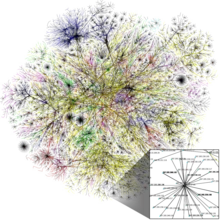| Internet |
|---|
 |
|
|
Internet geography, also called cybergeography, is a subdiscipline of geography that studies the spatial organization of the Internet, from social, economic, cultural, and technological perspectives.[1][2] The core assumption of Internet geography is that the location of servers, websites, data, services, and infrastructure is key to understand the development and the dynamics of the Internet. Among the topics covered by this discipline, of particular importance are information geography and digital divides.[3]
References
- ↑ Green, Emma (2013-09-09). "Mapping the 'Geography' of the Internet". The Atlantic. Retrieved 2015-09-15.
- ↑ Warf, Barney (2012-08-01). Global Geographies of the Internet. Springer Science & Business Media. ISBN 9789400712454.
- ↑ Graham, Mark; De Sabbata, Stefano; Zook, Matthew A. (2015-06-01). "Towards a study of information geographies: (im)mutable augmentations and a mapping of the geographies of information". Geo: Geography and Environment. 2 (1): 88–105. doi:10.1002/geo2.8. hdl:2381/40536. ISSN 2054-4049.
External links
- Information Geographies Archived 2020-08-12 at the Wayback Machine at the Oxford Internet Institute
This article is issued from Wikipedia. The text is licensed under Creative Commons - Attribution - Sharealike. Additional terms may apply for the media files.